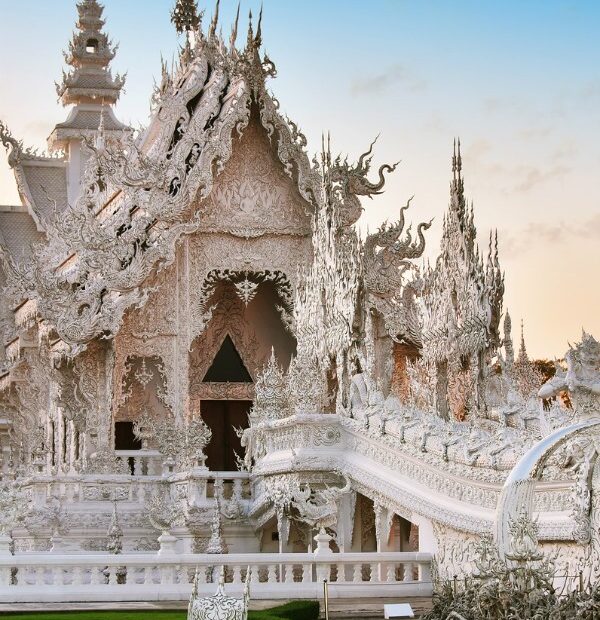Table of Contents
Introduction
Thai temples, known as “wats”, are architectural wonders that offer insight into Thailand’s rich cultural heritage. As sacred sites of worship in Theravada Buddhism, they showcase exquisite craftsmanship passed down through generations. A visit to Thailand’s temples takes you on a journey across different eras, styles, and spiritual practices. Their elegant towers, lavish decorations, and tranquil courtyards provide a tranquil sanctuary from busy urban life. This article explores the architectural diversity, renowned temples, spiritual rituals, and preservation efforts that make Thai temples an awe-inspiring destination for travelers.
Architectural Styles
Thailand’s temples display diverse architectural influences that evolved over centuries.
Traditional Thai architecture is characterized by towering, multi-tiered roofs that sweep upward. Made of colorful ceramic tiles or golden swirls, they represent ascending to spiritual heights. Intricate wood carvings and mural paintings adorn the exterior.
Khmer architecture from the Khmer Empire left its mark with the prang – a towering spire reminiscent of Cambodian temples like Angkor Wat. Brick and stucco materials added durability and allowed more elaborate decorated surfaces.
Chinese styles arrived with traders and immigrants. Chinese-influenced wats have striking guardian dragons and sharp curved eaves on tiered rooftops. Gold leaf and ceramic embellishments imbue grandeur.
Famous Thai Temples
Certain temples stand out for their history, artistic mastery, and sacred relics.
The Temple of the Emerald Buddha, or Wat Phra Kaew, within Bangkok’s Grand Palace enshrines Thailand’s most revered Buddha statue. Its exquisite emerald Buddha sculpture sits atop a gold, jewel-encrusted throne, while the temple dazzles with mosaic mirrors and mythological murals.
Wat Pho in Bangkok impresses with its enormous reclining Buddha stretching nearly 50 meters long. Its mother-of-pearl inlaid soles exhibit 108 auspicious signs. The temple complex also hosts a highly respected massage school.
The Temple of Dawn, or Wat Arun, towers 70 meters over the Chao Phraya River in Bangkok. Its imposing central prang is encrusted with colorful Chinese porcelain arranged in floral patterns.
Interior Design
Step inside the main prayer hall, called bot or ubosot, to admire stunning interior craftsmanship. Gilded Buddha images sit on altars surrounded by flower garlands, candles and incense. Elaborately painted murals narrate Buddhist tales on the walls. Intricate wood carvings depict flowers, guardian spirits or celestial beings across columns and pediments.
Exteriors
Approaching a wat, your eye is drawn upwards to the towering prang spire. Prangs taper elegantly to a finial topped with tridents and pennants symbolizing Buddhist cosmology. Exquisite stucco work or colorful ceramic shards adorn their surface.
Entry is through gates called gopuram, decorated with carved wooden panels or guardian figures. Inside, a monumental chedi pagoda holds relics of Buddha or an important monk. Galleried walkways and serene courtyards connect the sanctuary halls for meditation and chanting.
Spiritual Practices
Temples come alive with fervent spiritual activity. At sunrise, monks in saffron robes commence chanting blessings behind temple walls. Locals offer alms and food to monks during the morning tak bat ceremony. Visitors can partake by placing rice into a monk’s alms bowl.
Inside main halls, locals make offerings of flowers, incense and candles at Buddha altars. They ring bells and chant to make merit, kneeling in solemn prayer with palms joined. Sitting cross-legged in meditation is common as monks guide novices. doctrines. Tranquil inner sanctums foster contemplation.
Temple Etiquette
Proper etiquette allows you to show respect when visiting temples. Both men and women should have shoulders and knees covered. Remove your shoes before entering any buildings. Sit with your feet pointing away from Buddha images. Avoid pointing your feet towards monks or novices, as feet are considered lowly and unclean. Maintain quiet voices so as not to disturb others praying.
Impact on Tourism
Thai temples have become hugely popular tourist magnets. Grand temples like Wat Phra Kaew and Wat Pho are filled with admiring crowds snapping photos. Tour operators feature temple visits in Bangkok and northern cities like Chiang Mai or Chiang Rai. This brings economic benefits to cities promoting “temple tourism”. To control overcrowding, certain temples now charge entrance fees and restrict flash photography.
Preservation Efforts
While heavily visited temples undergo periodic restoration, rural wats struggle with termites, humidity and erosion. Both public and private efforts aim to preserve these architectural treasures. The Fine Arts Department oversees maintenance and repairs for significant structures. UNESCO recognizes some as World Heritage Sites, giving access to global funding. Non-profit groups like Friends of Thai Temples volunteers their time for upkeep projects. New temple construction still thrives by adapting old styles to modern materials.
Conclusion
A journey through Thai temples offers a window into the kingdom’s historic culture and Buddhist devotion. No matter your faith, the tranquil beauty and craftsmanship of these sacred sites inspires awe. The Thai people rightly take pride in preserving this architectural and artistic heritage for future generations. Wandering historic wats lets visitors connect with Thailand’s past and spiritual essence in an enriching way.
FAQ
What is the architectural difference between Thai and Cambodian temples?
Thai temples emphasize towering tiered roofs, while Cambodian Khmer temple architecture favors taller spires or prangs.
What should you wear to visit a Thai temple?
Dress conservatively with shoulders and knees covered as a sign of respect.
How can I show respect inside a temple?
Remove your shoes, speak quietly, keep your feet pointed away from Buddha images, and sit or kneel modestly.
What is the optimal time of day to visit temples?
Early morning hours let you witness monks chanting prayers and accepting alms.
What etiquette should I follow around monks?
Avoid touching monks or passing anything directly to them. Keep your head lower than theirs as a sign of deference.
